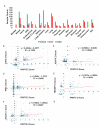Regulation of DNA repair gene expression by PRMT5
- PMID: 40735501
- PMCID: PMC12305363
- DOI: 10.17912/micropub.biology.001631
Regulation of DNA repair gene expression by PRMT5
Abstract
PRMT5 is a member of a class of enzymes called protein arginine methyltransferases (PRMTs) that play a role in maintaining genomic stability through post-translational modification of components of the TIP60 chromatin remodeling super complex. TIP60 is required primarily for chromatin remodeling at DNA double-strand breaks. Mutations in either TIP60 or PRMT5 affect repair by homologous recombination. A recent study has shown that in leukemia and lymphoma, PRMT5 also controls mRNA expression of TIP60 and other DNA repair genes by regulating alternative splicing. This analysis utilizes publicly available data from the Catalogue of Somatic Mutations in Cancer (COSMIC) to interrogate how PRMT5 expression correlates with expression levels of other key DNA repair genes: KAT5 (TIP60), H2A (H2AFX), TP53, TP53BP1, and RAD51 in all cancers. We find that indeed an increase in PRMT5 expression levels correlates with an increase in KAT5 levels. A weak correlation was also observed between PRMT5 and TP53, TP53BP1, and RAD51. These findings extend previous PRMT5 roles in controlling gene expression to all cancer types and further highlight the role of this enzyme not only in post-translational modification but also regulation of gene expression.
Copyright: © 2025 by the authors.
Conflict of interest statement
The authors declare that there are no conflicts of interest present.
Figures

Similar articles
-
In silico protein structural analysis of PRMT5 and RUVBL1 mutations arising in human cancers.Cancer Genet. 2025 Apr;292-293:49-56. doi: 10.1016/j.cancergen.2025.01.002. Epub 2025 Jan 17. Cancer Genet. 2025. PMID: 39874873 Free PMC article.
-
Protein arginine methyltransferase 5 sustains Tip60-EP400 complex via SRSF1 in Merkel cell carcinoma.Life Sci Alliance. 2025 Aug 22;8(11):e202503316. doi: 10.26508/lsa.202503316. Print 2025 Nov. Life Sci Alliance. 2025. PMID: 40846633 Free PMC article.
-
Can a Liquid Biopsy Detect Circulating Tumor DNA With Low-passage Whole-genome Sequencing in Patients With a Sarcoma? A Pilot Evaluation.Clin Orthop Relat Res. 2025 Jan 1;483(1):39-48. doi: 10.1097/CORR.0000000000003161. Epub 2024 Jun 21. Clin Orthop Relat Res. 2025. PMID: 38905450
-
Systemic pharmacological treatments for chronic plaque psoriasis: a network meta-analysis.Cochrane Database Syst Rev. 2017 Dec 22;12(12):CD011535. doi: 10.1002/14651858.CD011535.pub2. Cochrane Database Syst Rev. 2017. Update in: Cochrane Database Syst Rev. 2020 Jan 9;1:CD011535. doi: 10.1002/14651858.CD011535.pub3. PMID: 29271481 Free PMC article. Updated.
-
Systemic pharmacological treatments for chronic plaque psoriasis: a network meta-analysis.Cochrane Database Syst Rev. 2020 Jan 9;1(1):CD011535. doi: 10.1002/14651858.CD011535.pub3. Cochrane Database Syst Rev. 2020. Update in: Cochrane Database Syst Rev. 2021 Apr 19;4:CD011535. doi: 10.1002/14651858.CD011535.pub4. PMID: 31917873 Free PMC article. Updated.
References
-
- Clarke TL, Sanchez-Bailon MP, Chiang K, Reynolds JJ, Herrero-Ruiz J, Bandeiras TM, Matias PM, Maslen SL, Skehel JM, Stewart GS, Davies CC. PRMT5-Dependent Methylation of the TIP60 Coactivator RUVBL1 Is a Key Regulator of Homologous Recombination. Mol Cell. 2017 Feb 23;65(5):900–916.e7. doi: 10.1016/j.molcel.2017.01.019. - DOI - PMC - PubMed
Grants and funding
LinkOut - more resources
Full Text Sources
Research Materials
Miscellaneous
